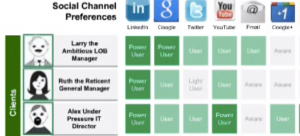IBM recently conducted a webinar titled “5 Key Strategies for Omni-Channel Marketing” in which they discussed the following strategies:
- Collect data that helps create customer profiles
- Analyze that customer data to find actionable insights
- Decide how to allocate your budget across the right channels to reach the right audiences
- Manage the interactions with customers across the channels
- Optimize your messages, offers, and capture reactions to feed the data collection process

Within each of the overall strategies, IBM did a good job of providing details about how you go about implementing the strategies. I’ll briefly talk about each strategy below:
To collect data, you have to look at all the sources of data about customers and their behaviors to which you have access. Sometimes you will want to pull this data into a central datamart or data warehouse. Broadly, these sources can be broken down into:
- Web Analytics across your digital channels, including paid, owned and earned channels. You should also be capturing analytics from your mobile apps if you have any. You can also use attribution models to help you understand the kinds of data to collect.
- Offline data comes from CRM, catalog inquiries and call center activity. We think you should be using online tools for CRM and call centers and capture data about customer interactions automatically. You might need to convert some of this data into customer profile information. For example, if a customer calls your help line four times in a month, you may count that person as highly engaged versus somebody that called once in the last year.
- Real-time data includes items such as shopping cart activity, social media content, and intra-session data.
Now that you have collected data (often massive amounts of data), it is time to analyze it by building out a customer profile. Sometimes this is called a 360 view of the customer. Data collected has to be converted into meaningful information about the customer to build this profile. Here are some of the profile information we want to analyze:
- What behaviors does the customer exhibit? How frequently do they interact with us? What purchasing stage are they in?
- What are the demographics we can discern about the customer? What gender, age, sex, income category, etc?
- How about the customers technographics? Are they using a mobile device? What size screen do they use? Do they use a Mac vs Windows?
- Does the customer have preferences in the form of a preferred channel, contact time, etc?
- What interests does the customer have?
In the analysis phase, we want to discover or uncover insights about our customers. We can use this information to develop key segments and personas, so can target our customers with the right messages.
After developing segments and personas, it is time to decide how to allocate your marketing budget to reach the right audience. Here you want to plan how deliver a consistent message across the multiple channels you’ve identified in your customer profiles. At the same time, you may need to plan how to customize your message for the persona you are going after. Finally, you may need to develop marketing triggers to fire off a message at the right time for your audience.
If you’ve made it this far, you probably realize that you have to manage this data and these processes. Marketing automation tools are really helpful here as they can automate the process of getting your message at the right time (say cart abandonment) to the right persona or segment.
Undoubtably, optimizing this whole lifecycle is a major undertaking. The amount of data being collected about your customers can be overwhelming. Reacting to market events requires agility. It takes times to see and understand changes in your customers’ changing demographics or technographics. How quick was mobile adoption?
The good news is that major vendors like IBM have been developing marketing automation software over the past several years. To learn more about these 5 strategies, you can watch a video made from the webinar.
